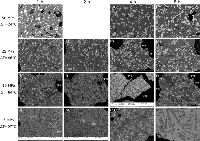Plagioclase nucleation and growth kinetics in a hydrous basaltic melt by decompression experiments
Arzilli F., C. Agostini, P. Landi, A. Fortunati, L. Mancini, M.R. Carroll (2015).
Cotributions to Mineralogy and Petrology, 170, 5/6, doi:10.1007/s00410-015-1205-9.
Abstract
Isothermal single-step decompression experiments (at temperature of 1075 °C and pressure between 5 and 50 MPa) were used to study the crystallization kinetics of plagioclase in hydrous high-K basaltic melts as a function of pressure, effective undercooling (ΔT eff) and time. Single-step decompression causes water exsolution and a consequent increase in the plagioclase liquidus, thus imposing an effective undercooling (∆T eff), accompanied by increased melt viscosity. Here, we show that the decompression process acts directly on viscosity and thermodynamic energy barriers (such as interfacial-free energy), controlling the nucleation process and favoring the formation of homogeneous nuclei also at high pressure (low effective undercoolings). In fact, this study shows that similar crystal number densities (N a) can be obtained both at low and high pressure (between 5 and 50 MPa), whereas crystal growth processes are favored at low pressures (5–10 MPa). The main evidence of this study is that the crystallization of plagioclase in decompressed high-K basalts is more rapid than that in rhyolitic melts on similar timescales. The onset of the crystallization process during experiments was characterized by an initial nucleation event within the first hour of the experiment, which produced the largest amount of plagioclase. This nucleation event, at short experimental duration, can produce a dramatic change in crystal number density (N a) and crystal fraction (ϕ), triggering a significant textural evolution in only 1 h. In natural systems, this may affect the magma rheology and eruptive dynamics on very short time scales.


